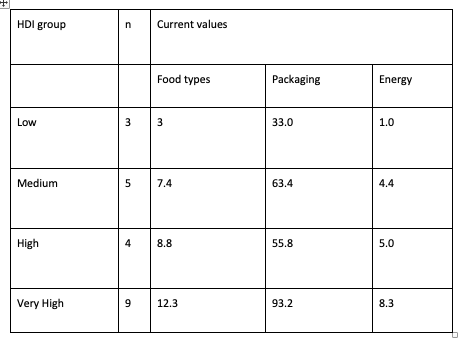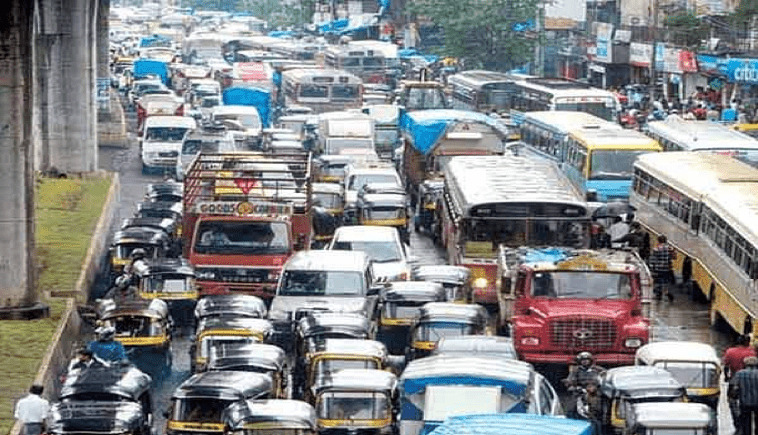IPAT, why?
This article is among a series revisiting the IPAT equation. Briefly, Paul Ehrlich [1] and colleagues in the 1970s [2] formulated this relation, that states that impact of a society is based on three main components – the number of people (Population), their level of consumption or income (Affluence) and the type and breadth of materials and energy that typify their patterns of consumption (Technology). But the lessons from IPAT have not been heeded, giving us the Great Acceleration, transgression of planetary boundaries, the Anthropocene and accelerating climate change. [3] This revisit to IPAT is intended to give people (companies or even countries) a practical and communicable ’calculator’ to understand how to reduce their own footprint.
What is ‘technology’?
‘Technology’ here is our mode of material production and consumption – and includes material and energy components. Physical materials – wood, concrete, plastics, fabrics, foods – all have been extracted from nature in some form, or are synthesized and transformed in manufacturing processes. Energy is included here too, as energy obeys the laws of physics and must be captured from nature to be used, whether from fossil fuels, the sun, wind or another source. Energy enables us to do ‘work’ to move things, make more things and transform things.
Materials
By the laws of physics, matter is conserved. Wood is cut, made into a table and then discarded, or recycled as chips, re-manufactured into chipboard and then discarded. Perhaps, the chipboard finally gets transformed into charcoal and burned. The ash and carbon dioxide are the final waste, at least until the carbon dioxide is incorporated into new plant tissue, or dissolved into carbonic acid in the ocean. The same is true for plastics, whether discarded after a single use, melted into pellets and remade into another object, and then finally discarded or incinerated. Across all materials used, waste is produced, that ends up in the earth, waters or atmosphere, in some other form.
Energy
Energy enables us to capture and work significantly larger amounts of matter, beyond our biological bodies and needs, to affect larger areas and volumes of physical space. Not all energy sources are the same; early fire harnessed to cook or manage grasslands was hard to control, only a small proportion of the energy was used in productive work (eg. cooking), but the waste (eg. ash) was natural, often useful (eg. fertilizer) and limited in abundance. By contrast, energy extracted from fossil fuels has been harnessed into a vast array of processes that transform myriad materials which themselves have waste implications, and carbon dioxide is a major waste product.
Both material and energy have become large enough impact terms to change environmental quality and climate at a planetary scale. The benefit of renewable energy sources – eg. solar, wind, geothermal, wave – is their minimal generation of material waste and, with progressive innovations, greater efficiency in conversion to work.
Knowledge/information
The role of knowledge and information is perhaps counter-intuitive. Expanded knowledge is what has enabled humanity to transcend the limitations of a particular time and place, and harness new materials and energy forms. Though intangible, knowledge itself may contribute to impact. The agricultural revolution gave the innovations of writing and money, two key technologies needed to not only handle the production, distribution and exchange of an increasing amount and diversity of material objects, but also to archive and transmit knowledge. The scientific and industrial revolutions gave us access to and dominion over vast material resources. Now, with digital computing we are tripping into the 4th industrial revolution or information age, in which we can only guess the quantum leaps in energy and material use that may come, and transcendence of current limitations. Just as energy has done for material use, information has played a role as a multiplier or amplifier of impact.
Measuring to reduce technology
Measuring matter and energy, let alone information, is highly complex. But for our purposes basic principles suffice. Consider a recent figure – that 90% of all terrestrial mammalian biomass on earth is livestock [4]; though we are just one among 6,495 mammalian species, we have transformed food webs so that 90% of this biomass feeds just us, 1 species.
To improve relevance to ‘consumers’ my focus for measurement is heuristic, focusing on proportional reduction of impact, rather than high technical accuracy. For example, how to motivate people to reduce consumption of red meat so that we only eat, say, 50% of all mammals? The simple analysis of household food [5]illustrates this. I used a basic ranking of food types (1-vegetable/grain; 2-fish/aquatic; 3-meat/dairy; 4- Processed/high value (biscuits, wine, alcohol, crisps, chocolate, sugary drinks), packaging types (1- Cardboard/Cartons/Glass; 2- Tins/plastic (reusable)/Cans; 3- plastic single use) and energy sources (1-biomass; 2-compressed gas; 3-electricity), with 1 being the least impactful. All individual or recognizable items were classified and the scores summed. The averages for each HDI country group (table 1 below) clearly show the increased impact with increasing income levels[6], and clear targets for households to reduce their use of high-impact food, packaging and energy sources, even if they can’t measure each precisely. The need for greater impact reduction in High income households is clear, as is the need to provide for increased income levels (indicated by e.g. use of more food types and greater energy use) in low income households.

This of course needs to be done across all areas of technology – fuel, housing, holidays, computers, mobile phones, plastics, etc. Of course, to support this action and assure impact, more technical measurement of real impact will be needed.
Reducing impact
Material, energy and information content in the Technology term can vary across an extremely wide range, based on the types of material and energy and how information is used. 100 years ago a single flight carrying 450 passengers across the Pacific from Los Angeles to Singapore was unthinkable, and 20 years ago we could not imagine the internet as it is today – we should also not limit our imagination of how much future inventions could reduce these to zero – if only we would incentivize the quest for them. For business, transforming from linear to circular practices would reduce final waste to as close to zero as possible, and internalize (into the price of an item) what are currently external costs (in environmental pollution and its consequences, eg. in health).
Energy use can be improved by increasing the efficiency of converting energy into productive work, and use of cleaner non-polluting energy sources. We have come from 5% to 35% efficiency in extracting useful work from energy sources, from early to advanced industrial agriculture … how much higher could this be pushed?. While all ‘revolutions’ to date (agricultural, scientific, industrial, information) have resulted in greater material and energy use, and production of waste, does this need to continue? Indeed, with the clear recognition now of exceeding planetary limits, it is possible that new knowledge and use of information, energy and materials, can reverse the trend to not only stabilize impact, but reduce it below a single planet Earth. This could be done by policy switches away from fossil fuels to zero-emission energy sources (e.g. wind, solar, geothermal, etc); while there are development costs to these, a clear and consistent policy switch can promote innovation, employment and myriad development opportunities which, because they are valued, would be counted as investments, rather than as costs as they are in a world still pursuing fossil fuel use.
In my IPAT article I used impact reduction factors of 30/20/10/0 per cent by 2030 for Very High, High, Medium and Low HDI countries, respectively, and of 70/70/60/50 per cent by 2100, to keep impact to current levels. I find it hard to believe, given the profound changes in global society, economy, science and technology in the last 100 or even 20 years, that these are not possible.
It likely requires a profound value change, however the icing on the cake is that this value change will likely result in improvements to welfare and wealth, not just increased costs. In this sense it may be possible to have our (sustainable) cake and eat it too. Success requires all significant groups of people (measured by their population size and/or contribution to global impact, ie. major corporations too!) to agree that investing in these new and different technologies IS worthwhile, rather than just being a cost. Can this renewed use of IPAT help contribute to building the individual will necessary to enable this collective action?
David Obura has a PhD in marine ecology, researching global and local threats to coral reefs. He is a Director of CORDIO East Africa (www.cordioea.net), which supports research, monitoring and capacity building around coral reefs and coastal ecosystems in the Western Indian Ocean, promoting inclusive and sustainable approaches to development.
The MAHB Blog is a venture of the Millennium Alliance for Humanity and the Biosphere. Questions should be directed to joan@mahbonline.org
1.Obura, D.O. The Three Horses of Sustainability—Population, Affluence and Technology. Preprints 2018, 2018120176 (doi: 10.20944/preprints201812.0176.v1); visit this page for links to the other articles as they are prepared: https://cordioea.net/ipat/
2. Ehrlich P.R. & Holdren J.P. Impact of Population Growth. Science, 1971 171, 1212–1217.
3. Varied references for these – Rockström J., Steffen W.L., Noone K., Persson A., Chapin F.S. III, Lambin E., Lenton T.M., Scheffer M., Folke C., & Schellnhuber H.J. Planetary boundaries: exploring the safe operating space for humanity. Ecology and Society, 2009 14, 1–32; Steffen W., Broadgate W., Deutsch L., Gaffney O., & Ludwig C. The trajectory of the Anthropocene: The Great Acceleration. The Anthropocene Review 2015 2, 81–98.; Crutzen P.J. Geology of mankind, Nature 2002 415, 23; IPCC Fourth Assessment Report. Climate Change 2007: Working Group I: The Physical Science Basis. Section 2.3.1 Atmospheric Carbon Dioxide. (2007)
4. https://mammaldiversity.org/
5. In my IPAT article, see footnote 1, and assessing the images of household weekly food use in the images at Menzel P. Hungy Planet family food portraits. 2013. Available at: https://menzelphoto.photoshelter.com/gallery/Hungry-Planet-Family-Food- Portraits/G0000zmgWvU6SiKM/C0000k7JgEHhEq0w [Accessed 1 May 2018]
6. except for the high use of plastics and individual packaging in Medium income countries.
The views and opinions expressed through the MAHB Website are those of the contributing authors and do not necessarily reflect an official position of the MAHB. The MAHB aims to share a range of perspectives and welcomes the discussions that they prompt.
